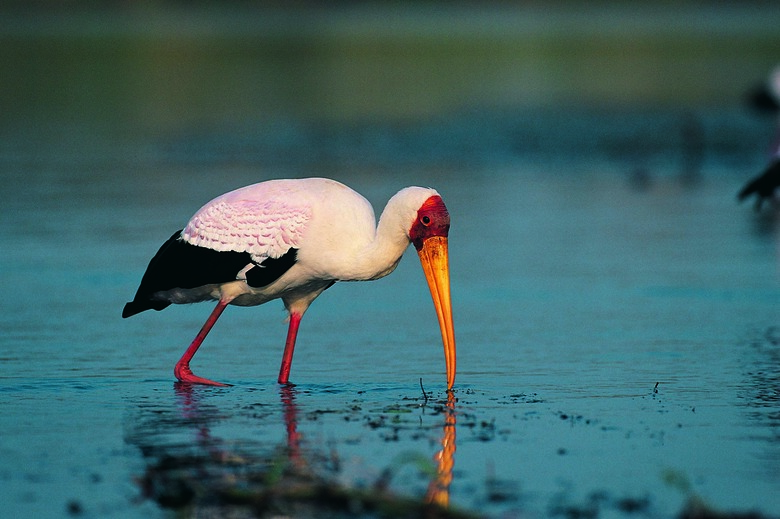Examples Of Indicator Species
We define an indicator in biology as an organism that the presence, or lack thereof, provides a clear signal about the environmental conditions. Depending on the organism, its appearance can signal both a healthy ecosystem or an unhealthy one. These indicators can reveal information about many factors in an environment, including pollution levels, salinity, temperature and nutrient or food availability.
Types of Indicator Species
Types of Indicator Species
There are many examples of indicator species. Indicator species can be anything from bacteria to more complex organisms such as plants and animals. While everything has evolved to live within certain thresholds, so all organisms are indicators of something; many are considered particularly sensitive and provide a good indication of the initial changes in environmental conditions.
The Wood Stork (Mycteria americana)
The Wood Stork (Mycteria americana)
Lack of wood storks in everglade ecosystems in the United States indicate that the environment is not suitable to sustain abundant wading bird life. Wood storks once thrived in these wetland environments by feeding on small freshwater fish. Conservationists use wood storks as a model example for the health of the everglades. The success of water-management restoration on wood stork populations helps indicate whether or not efforts are improving the overall everglade conditions to sustain all bird, fish, animal and plant life.
Peppered Moth (Biston betularia)
Peppered Moth (Biston betularia)
The evolutionary changes of the peppered moth in Britain in the 1950s from white to black was an indication of the high levels of pollution in the region. The theory goes that due to the trees being heavily covered in black soot, this put selective pressure on the moths with darker melatonin pigmentations as lighter moths were easily seen by birds. The darker moths were more camouflaged and therefore, more reproductively successful. Later in the 1970s, researchers found lower rates of the darker moths, which was thought to be due to less coal pollution on the trees and therefore it was once again advantageous to be paler.
River Otters (Lontra canadensis)
River Otters (Lontra canadensis)
River otters feast mostly on crayfish and fish but also other invertebrates, amphibians and smaller mammals. As one of the common keystone species examples and apex predators, if there is a problem lower down in the food chain, otters are typically the first to start declining. The success of river otter reintroductions has been used to assess the health of freshwater ecosystems.
River otter health has also been used to determine mercury pollution in an environment. Bioaccumulation is when chemicals or heavy metals gradually accumulate in an organism. Since mercury bioaccumulates and river otters are at the top of the food chain, they will likely be the first to show signs of mercury poisoning.
Frogs
Frogs
Frogs have highly semi-permeable skin that must remain moist for them to breath. Their skin makes them bioindicators for the health of their environment as they are vulnerable to absorbing chemical pollutants in their habitat. Many frogs have life stages that utilize both terrestrial and freshwater ecosystems, which also makes them sensitive to environmental stressors such as a change in temperature and UV-radiation.
Buck's Horn Plantain (Plantago coronopus)
Buck's Horn Plantain (Plantago coronopus)
Some plant species have developed mechanisms for coping with salt in the soil such as salt exclusion and cellular osmotic adjustment. Plants that don't have these mechanisms will not be able to grow in areas with high salinity. Buck's horn plantain is a useful ecological indicator example of salt concentration in Australian soils as its leaves get redder as the salt in the soil increases.
Algal Blooms
Algal Blooms
Algal blooms can indicate a change in the environment. An increase in nutrients from sedimentation runoff can cause an algal bloom. Algal blooms may also correlate with natural seasonal changes in nutrient availability. The concentration of algae across an area is also a useful indicator of gradients in nutrient availability in a body of water.
Lichens
Lichens
Lichens are a combination of various fungi and algae or bacterial species. Different functional traits and responses of lichens occur based on air pollution and temperature. Therefore, the presence of different types of lichens is useful for determining the effects of urbanization on the environment. For example, medium to high levels of urbanization is correlated with lichens made of chlorococcoid green algae and those with foliose narrow lobes. In contrast, low-density urbanized areas feature more cyanolichens and Trentepohlia algae lichens with a crustose formation.
References
- BiologyOnline.org: Indicator Species
- Encyclopedia Britannica: Indicator Species
- Encyclopedia of Life: What Is an Indicator Species?
- World Wildlife Fund: Global Species Programe: How WWF Classifies Species
- National Park Service: Wood Stork: Species Profile
- Ecotoxicology: Factors Influencing Exposure of North American River Otter (Lontra Canadensis) and American Mink (Neovison Vison) to Mercury Relative to a Large-Scale Reservoir in Northern British Columbia, Canada
- Agriculture Victoria: Salinity Indicator Plants
- Eutrophication in Coastal Ecosystems: Potential Phytoplankton Indicator Species for Monitoring Baltic Coastal Waters in the Summer Period
- Science of the Total Environment: Selecting Lichen Functional Traits as Ecological Indicators of the Effects of Urban Environment
- Intech Open: Algae as an Indicator of Water Quality
- Encylopaedia Britannica: Peppered Moth
- Science Direct: Bioaccumulation
Cite This Article
MLA
Jerrett, Adrianne. "Examples Of Indicator Species" sciencing.com, https://www.sciencing.com/examples-indicator-species-16895/. 31 July 2019.
APA
Jerrett, Adrianne. (2019, July 31). Examples Of Indicator Species. sciencing.com. Retrieved from https://www.sciencing.com/examples-indicator-species-16895/
Chicago
Jerrett, Adrianne. Examples Of Indicator Species last modified August 30, 2022. https://www.sciencing.com/examples-indicator-species-16895/
